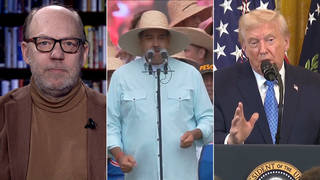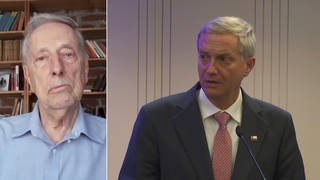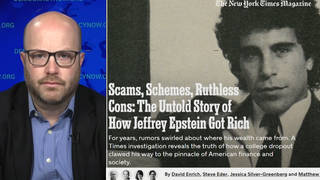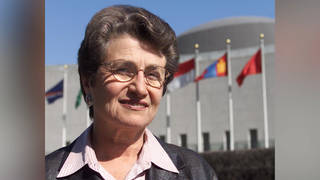
Guests
- Nick TurseVice News contributor and author. His latest article is titled “A Slaughter in Silence.” He is the author of the book Next Time They’ll Come to Count the Dead: War and Survival in South Sudan.
The Democratic Republic of Congo is facing one of the worst humanitarian crises in the world as a wave of extreme violence sweeps the country. Some 2 million Congolese fled their homes last year, nearly 7 million Congolese are now internally displaced, and another 500,000 have fled to other parts of Africa. According to the United Nations, 13 million Congolese are in urgent need of humanitarian aid. The international media has largely ignored what’s happening, but this week Vice News published a shocking investigation into a recent case of ethnic cleansing. Hundreds of machete-wielding militiamen swept through areas in Congo near the Ugandan border, attacking around 120 communities. Hundreds were killed, thousands of homes were destroyed, and some 350,000 people were displaced. The violence came after the U.S. abruptly cut support for peacekeeping efforts in the Congo and elsewhere last year as part of President Trump’s “America First” policies. We speak with Vice News contributor and author Nick Turse. His article is titled “A Slaughter in Silence: How a brutal ethnic cleansing campaign in DRC was made worse by Trump’s 'America First' policies and the world’s neglect.”
Transcript
AMY GOODMAN: We begin in the Democratic Republic of Congo, which is facing one of the worst humanitarian crises in the world. Between 1998 and 2003, the DRC suffered what has been described as the deadliest conflict since World War II. More than 5 million Congolese died. Well, 15 years after the war ended in Congo, the country is facing another massive crisis, a wave of extreme violence sweeping the DRC. Last year 2 million Congolese fled their homes, nearly 7 million Congolese are now internally displaced, and another half a million have fled to other parts of Africa. According to the United Nations, 13 million Congolese are in urgent need of humanitarian aid.
The international media has largely ignored what’s happening. But this week, Vice News published a shocking investigation into a recent case of ethnic cleansing, where hundreds of machete-wielding militiamen swept through areas in Congo near the Ugandan border. About 120 communities were attacked, with hundreds killed, thousands of homes destroyed, some 350,000 people displaced. The violence came after the U.S. abruptly cut support for peacekeeping efforts in the Congo and elsewhere last year as part of President Trump’s “America First” policies.
For more, we’re joined by Vice News contributor, author Nick Turse. His article is headlined “A Slaughter in Silence: How a brutal ethnic cleansing campaign in DRC was made worse by Trump’s 'America First' policies and the world’s neglect.” He’s also author of the book Next Time They’ll Come to Count the Dead: War and Survival in South Sudan.
Nick, welcome back to Democracy Now! Explain exactly what you’ve uncovered.
NICK TURSE: Well, I went to the Democratic Republic of Congo earlier this year to cover existing conflicts and the resulting refugee crisis, but I found myself witness to an unfolding ethnic cleansing campaign in the far east of Democratic Republic of Congo, a placed called Ituri province, and specifically a region called Djugu territory. And there, the minority Hema community was being attacked relentlessly—in the time I was there, sometimes more than one attack per day on villages. There were about 120 attacks during this campaign. Hundreds were killed. Hundreds of thousands were driven from their homes. Most of them became internal exiles inside of Congo, and then about 50,000 or so were driven across the border into Uganda.
AMY GOODMAN: Who’s doing this?
NICK TURSE: Well, it’s a very murky circumstance trying to find who is exactly behind this. When you talk to most people there, they say that it isn’t an ethnic conflict, which it’s been portrayed as outside of the country. They say that there’s an invisible hand behind it. And when you delve into that further, basically what it’s meant is that powerful politico-military forces are behind this. Many people link it to President Joseph Kabila, who’s stayed in office as president two years beyond his legal mandate. And he has a—there’s an election coming up, presidential election, in December. A lot of people think that this violence was orchestrated to help postpone that election or upend it completely.
AMY GOODMAN: How would it do it?
NICK TURSE: Well, they’re trying—you know, at the time that this violence broke out, the head of the electoral commission in the capital Kinshasa came out and said, “If there’s violence in Ituri province, then there’s a good chance that we can’t hold elections, because there will be too many—the population will be displaced, and we have to focus our resources on quelling the unrest there.” And at the exact same time, unrest broke out in Ituri province. A lot of people thought that that was too much of a coincidence to be strictly a coincidence.
AMY GOODMAN: I want to turn to an earlier report on Vice News Tonight describing the violence in Ituri province. A word of caution to our TV viewers: Some of these images are extremely graphic.
ARIS ROUSSINOS: The Lendu and Hema are two neighboring ethnic groups who’ve fought one another in the past. But since 2007, they’ve lived in relative peace. Not anymore. A Lendu militia has been targeting the Hema since December, burning villages and killing more than 250 people. Just days before we arrived in Maze village, a Lendu militia allegedly slaughtered more than 40 Hema villagers. It was one of the worst cases of ethnic violence in recent memory.
DAVIDE ITSOBWA: [translated] They came in with the machetes. In this village, we lost…
ARIS ROUSSINOS: [translated] There are many women?
DAVIDE ITSOBWA: [translated] Yes, there are many women. And among the women, many are elderly.
ARIS ROUSSINOS: Davide Itsobwa lost 15 family members and has been investigating the massacre for human rights groups.
DAVIDE ITSOBWA: [translated] There were also children of 2 years, 3, 4, up to 20 years. There is another who lost a wife and children. He has also lost a child.
AMY GOODMAN: Can you elaborate on this, Nick?
NICK TURSE: Yeah, this was one of the largest of the massacres. It was a village called Maze. And people I spoke to said that 50 or more people were killed there. And the killings that were going on in Congo were especially brutal. I mean, we’re talking about—you know, it’s a world where war is increasingly associated with drones and smart bombs and cyberattacks. But the war on civilians that I witnessed there was carried out by militiamen who were wielding machetes, axes, bows and arrows, and spears. It was as brutal as it was merciless, and the militiamen there were attacking women, children, the elderly, without compunction.
AMY GOODMAN: Tell us some of the stories of the people you met with, the horror of their limbs being chopped off.
NICK TURSE: Yeah, there was—you know, there are so many stories that stick with me, but one is a family who tried to flee an attack on their village, Tche, which isn’t very far from Maze, which we just saw there in the clip. And the family was confronted by these militiamen on the way out of town, and four family members—a mother and three children—were killed during this.
An 11-year-old girl, the eldest daughter in the family, was attacked; she was cut several times, including militiamen cut off one of her hands. She woke up, and she told me that she saw bodies scattered all around, including her mother. She went over to her mother and found that her young sister, a 2-year-old, had been gravely wounded but was still alive. And she took a piece of fabric off of her mother’s body, wrapped up her sister onto her back, and then went, helped several other survivors in the village. She also found her father and eventually brought help to him. Other men who had fled the village had come back. She brought the men to him, and it saved all of their lives.
AMY GOODMAN: I want to go back to Vice News correspondent Aris [Roussinos], who visited an overcrowded refugee camp, which is home to thousands of people, mostly Hema, who fled from Lendu attackers.
ARIS ROUSSINOS: This tent is filled with families who bear some of the most brutal injuries. Can you tell me what happened to you?
NYINE RICHARD: [translated] They killed my wife and three children. They started to cut me with a machete, and the child who was in my hand.
ARIS ROUSSINOS: Nyine Richard’s 2-year-old daughter Rochelle now has these permanent scars to her face and skull.
MAVE GRACE NGABUSI: [translated] We were being chased.
ARIS ROUSSINOS: Her older sister, 11-year-old Mave Grace, watched her pregnant mother get hacked to death.
MAVE GRACE NGABUSI: [translated] I stopped when I saw that they were cutting my mother. But when they saw I stopped, they started cutting me, too. That’s how they cut my hand. Since there is still a war, I cannot go back home.
AMY GOODMAN: That report from Vice News. Nick Turse?
NICK TURSE: Yes, that was the family that I was speaking of. And Mave Grace was the one who saved her entire family. She saved other people from the village. She found a young boy who was gravely wounded and wandering through. She helped him. She told me that there were others that she couldn’t save. She saw a boy who both of his legs were cut off, and she said she wanted to help, but she knew there was nothing that she could do. And these stories, I was told again and again, village after village. It was just incredibly violent.
AMY GOODMAN: So what does this have to do with U.S. policy?
NICK TURSE: Well, experts that I talked to said that U.S. policy exacerbated this ethnic cleansing campaign, because in 2017 the U.S. ambassador to the United Nations, Nikki Haley, pushed for and won dramatic cuts to the U.N. peacekeeping budget. She took to Twitter afterwards to celebrate having cut half a billion dollars from peacekeeping efforts, and said this was only the beginning.
AMY GOODMAN: Let me turn to Nikki Haley speaking earlier this year.
NIKKI HALEY: Peacekeeping is a shared possibility. With shared responsibility comes shared burdens and shared costs. One country should not shoulder more than one-quarter of the U.N. peacekeeping budget. And we look forward to more equitable distribution of the budget among member states. Moving forward, the United States will not pay more than 25 percent of the peacekeeping budget. This is a cap required by U.S. law.
AMY GOODMAN: That’s the U.S. ambassador to the United Nations, Nikki Haley. Nick Turse?
NICK TURSE: Yes. You know, these cuts were severe, but even U.N. officials that I talked to and outside experts said that they were manageable, if they were done with some sort of orderly process. But the United States pushed for these cuts to be very severe and very fast. And because of that, the U.N. peacekeeping mission, I was told, had to move its forces and close down bases in a very haphazard fashion, that this had to be done very fast. Because of this, bases were shut down in Ituri province just before this violence broke out. And the people that I talked to, the experts, said that this hampered the response, that there could have been a faster U.N. response. And again, I should mention that these attackers were armed with traditional weapons—axes, arrows, machetes. U.N. peacekeepers are armed with modern automatic weapons. Most people said that if there was a robust peacekeeping presence, they would have saved lives, because the attackers wouldn’t have been able to stand up to them.
AMY GOODMAN: Who supports this overall U.N. peacekeeping force? It’s called MONUSCO?
NICK TURSE: Yes. MONUSCO is supported, in large part, by the United States, but other members of the international community also contribute to this force. But it was the U.S. that really led the charge to cut this budget. They said it was bloated. And they said that, you know, this was part of the “America First” agenda, that America shouldn’t be shouldering this type of financial burden.
AMY GOODMAN: I mean, you think back to the history of the Congo, over a century ago, when the Belgian King Leopold considered it his private fiefdom and killed—what? Something—well, well over 10 million Congolese.
NICK TURSE: Right.
AMY GOODMAN: The symbol of that time, the cutting off of hands.
NICK TURSE: Yeah. So you’re seeing that, you know, more than a century later, the same type of violence being meted out. And, you know, back then, the United States was the first country in the world to recognize Leopold’s claim on the Congo and supported his effort. And I couldn’t help but see some sort of symmetry in that.
AMY GOODMAN: So, what are people there calling for right now? And if you could place not only the Ituri province for us within Congo, but Democratic Republic of Congo within Africa, geopolitically, and its significance?
NICK TURSE: Sure. I mean, the Congo is a huge country. It’s about the size of Western Europe. So, it’s massive.
AMY GOODMAN: All of Western Europe.
NICK TURSE: All of Western Europe would fit inside the Democratic Republic of Congo. It’s in the heart of Africa, a tremendously large place, a poor country in terms of GDP, not poor when you look at the resources under the ground. There’s $24 trillion worth of mineral wealth beneath the ground in Congo. So there are always—you know, a lot of multinational corporations are interested in getting into Congo. But, you know, Congo has been plagued by rulers who don’t leave power and recurrent violence over the years.
AMY GOODMAN: At this point, your work in Africa has gone on for years. You wrote a book about South Sudan. You have written about, in the last year, the U.S. presence in Africa overall. Can you talk about that, even as it cuts aid to U.N. peacekeeping forces?
NICK TURSE: Yeah, the United States has had a robust military presence across the continent. It looks like that may be scaled back in the coming months as the U.S. pivots more towards near-peer competitors like Russia and China. But, actually, you know, I just checked in with U.S. Special Operations Command, and the number of commandos operating in Africa is the same as it was last year. So, there have been talks about cuts, but we haven’t seeing them yet.
You know, the United States has this presence as a—you know, the idea behind it is counterterrorism. They haven’t been all that successful. There’s actually a proliferation of terror groups across the continent. And missions over the years haven’t been all that successful. The United States, just a couple years ago, was heavily involved in Central Africa, including a small presence in Congo. It was aligned against Joseph Kony’s Lord’s Resistance Army. After close to a billion dollars spent, the United States was unable to capture or kill Kony. The LRA goes on. But that U.S. presence has faded.
AMY GOODMAN: And you have written, in your previous work, more U.S. commandos are deployed to Africa than to any other region of the world except to the Middle East.
NICK TURSE: That’s right. It’s been rapid growth since 9/11. You know, at that time, about 1 percent of U.S. commandos deployed overseas were in Africa. And now it’s running about 16 percent, more than any place other than the war zones in the greater Middle East.
AMY GOODMAN: From your travels there, what do you think needs to be done right now in the DRC?
NICK TURSE: Well, it’s humanitarian aid, is what people are asking for. And, you know, it wasn’t just these U.N. peacekeeping cuts that caused a tremendous amount of suffering there, but international aid to Congo has been dropping precipitously over the last years. If you look at last year’s numbers, you know, the average Syrian in need of humanitarian assistance received $305. The average Congolese in need of it received about $62. Now, I don’t begrudge Syrians in need any amount of money, but there’s a real disparity there. And experts that I talked to said, you know, people just don’t care about the Congo.
AMY GOODMAN: Nick Turse, thank you for being there and for reporting this horrific story. Nick Turse, Vice News contributor and author, his latest article headlined “A Slaughter in Silence: How a brutal ethnic cleansing campaign in DRC was made worse by Trump’s 'America First' policies and the world’s neglect.” He is also author of the book Next Time They’ll Come to Count the Dead: War and Survival in South Sudan.
This is Democracy Now! When we come back, a Mexican journalist seeking political asylum in the United States is freed by court order after seven months in a detention center with his son. He’ll speak to us live from El Paso. Stay with us.












Media Options